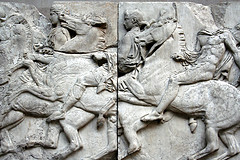 It’s always worth listening to Cliff Lynch‘s opening talks at the CNI task force meetings, and this week’s meeting in Washington was no exception. (My apologies for not blogging the meeting; busy week.) Like no one else, Cliff has his finger on the pulse of all that is new and important in the world of the digital humanities. Although Cliff discussed some issues that have received a lot of press, such as net neutrality, I found one issue he raised totally unexpected and fascinating.
It’s always worth listening to Cliff Lynch‘s opening talks at the CNI task force meetings, and this week’s meeting in Washington was no exception. (My apologies for not blogging the meeting; busy week.) Like no one else, Cliff has his finger on the pulse of all that is new and important in the world of the digital humanities. Although Cliff discussed some issues that have received a lot of press, such as net neutrality, I found one issue he raised totally unexpected and fascinating.
Cliff noted that digital surrogates for museum objects—that is, digital photographs or 2- or 3-D scans—are becoming so good that for most scholarly and classroom purposes they can replace the originals. For many years, one of the main arguments museums have used to avoid the repatriation of foreign materials—e.g., sculpture or pottery taken during colonization or war—is that they worried about the accessibility and condition of an object if they returned it. Scholars might lose important evidence, museums argued, and researchers often needed to look at the original object for small details like texture or paint color. With advances in digitization, however, this objection no longer holds water, and museums should feel more pressure (or more freedom) to repatriate controversial items in their collections.
[Creative Commons licensed photo of the Elgin Marbles courtesy of zakgallop on Flickr.]
Comments
This reminds me of a question posed in my Museum Informatics class at FSU by professorStu Paul Marty (originally posed by Diane M. Zorich): “Which is more important–the object, or the information ABOUT the object? What if you could *only* have one or the other–which would you choose?”
My head says that without information about an object–without knowledge of its context–an object is nearly meaningless. But my heart says there’s something magical about original objects. But if I HAD to choose, I’d go with the information.
Lynch’s point is a great one–digital surrogates can be so well made now that an object’s physical information is no longer restricted to the physical object itself. Scholars can now almost have their cake and eat it, too, which is tremendously beneficial. I do wonder, though, if there would ever be objection on the part of the original institution/nation/source of objects to that sort of detailed digital surrogate–would they claim even that information?
Good catch, Dan. I wonder how this connects with Roger Schonfeld’s presentation, which notes that overseas academics cited digital scholarly publications more frequently than did Amerians.
PS: blogged most of CNI at the NITLE blog. More sessions coming.
[…] any rate, the post in question is on digitization and repatriation. Specifically, he asks if digital objects, photos, etc. are so finely detailed that they convey as […]